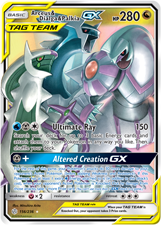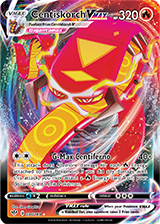The Pokémon Company recently released the latest installment of the Pokémon Trading Card Game as part of the latest Sword & Shield line. Read on below to learn more:
Sword & Shield—Vivid Voltage Deck Strategy: Donphan and Spiritomb
By Xander Pero, Contributing Writer
Since the return of two-Prize Pokémon in Black & White—Next Destinies, an incredible number of competitive decks have used these powerful behemoths with their high HP and strong attacks. However, there have been moments when specific one-Prize Pokémon, with their increased efficiency and type advantage, are strong enough to survive against these incredible Pokémon.
 A strong example of these standout one-Prize Pokémon has appeared in the newest expansion, Sword & Shield—Vivid Voltage, in Donphan. It requires only a single Energy to attack but, like many of its peers, has drawbacks in its requirement: it inflicts damage to its own Bench. Still, its strength against certain popular Pokémon that are weak to Fighting-type Pokémon—namely Pikachu & Zekrom-GX, Eternatus VMAX, Dedenne-GX, and Crobat V—makes it worthy of a closer look.
A strong example of these standout one-Prize Pokémon has appeared in the newest expansion, Sword & Shield—Vivid Voltage, in Donphan. It requires only a single Energy to attack but, like many of its peers, has drawbacks in its requirement: it inflicts damage to its own Bench. Still, its strength against certain popular Pokémon that are weak to Fighting-type Pokémon—namely Pikachu & Zekrom-GX, Eternatus VMAX, Dedenne-GX, and Crobat V—makes it worthy of a closer look.
There are multiple ways to feature Donphan in a deck, and surely more to be discovered. Here I’ll focus on pairing it with an already familiar card, Spiritomb. Read on to see what makes this deck rumble!
Core Cards
The entire purpose behind single-Prize attackers is their efficiency and favorable Prize trade, so ensuring steady attacks is key. To that end, I’ve kept my example deck somewhat simple and straightforward. The most important cards are maxed out at four copies each, including Spiritomb, Donphan, Cape of Toughness, and Aurora Energy. To top it off, there are eight card-drawing Supporters and nine search cards. All this deck needs to do is attach Energy and attack every turn—nothing too complex!
The deck uses a variety of support Pokémon: one copy each of Dedenne-GX, Crobat V, and Eldegoss V, so each effect is typically available once per game. The single copy of Crobat V is better than a second Dedenne-GX. Players will commonly use both in the same turn while digging for the finishing combo. Eldegoss V is great when you have an attacker ready and all you need is a Boss’s Orders. If a key Supporter is in your discard pile already, Eldegoss V can also be an effective counter against Reset Stamp.
I’ve also included Oricorio-GX to boost consistency. I like to wait until the first Donphan is Knocked Out to put Oricorio-GX on the Bench, but if you’re forced to play it earlier, that’s fine as well. Later in the game, the opponent will have to choose between removing your attacker or Oricorio-GX, which will be useful when closing out the game. Jynx accumulates damage on Spiritomb quicker, and also pushes its damage closer to one-hit Knock Out range immediately after one of Donphan’s Earthquake attacks. Lastly, Mew protects against any “sniper” decks like Decidueye or Inteleon V that can pick off Spiritomb before it can attack.
General Strategy
 One advantage to this deck is that your general strategy is the same against any opponent: load up a Donphan, accumulate damage on Spiritomb, and take Knock Outs when possible. This’ll involve using your search cards to prioritize Phanpy and Donphan first, then Spiritomb if you have extra. It’s extremely important to use Earthquake for two reasons. First, it does damage. Simply put, missing any opportunity to attack is a good way to lose games. Second, you miss out on putting damage on Spiritomb. The additional 20 damage on each Spiritomb—and potentially extra by moving some with Jynx—is game-changing. The reason I’ve lost good matchups is because I failed to use Earthquake on the first few turns of the game, meaning I fell too far behind and lost the Prize trade.
One advantage to this deck is that your general strategy is the same against any opponent: load up a Donphan, accumulate damage on Spiritomb, and take Knock Outs when possible. This’ll involve using your search cards to prioritize Phanpy and Donphan first, then Spiritomb if you have extra. It’s extremely important to use Earthquake for two reasons. First, it does damage. Simply put, missing any opportunity to attack is a good way to lose games. Second, you miss out on putting damage on Spiritomb. The additional 20 damage on each Spiritomb—and potentially extra by moving some with Jynx—is game-changing. The reason I’ve lost good matchups is because I failed to use Earthquake on the first few turns of the game, meaning I fell too far behind and lost the Prize trade.
Your ideal setup after the first turn is to have one or two Phanpy and at least one Spiritomb in play. The second Phanpy is worth playing if the first is at risk of being Knocked Out or you’re facing a deck with a Weakness to Fighting types. As stated previously, Phanpy is more important than Spiritomb initially—you might miss out on some damage from Building Spite, but you’ll be sorry if you miss the Earthquake. Donphan is a strong attacker regardless, and you shouldn’t feel bad setting up a second one because it can Knock Out a Dedenne-GX or Crobat V to finish the game.
If you’re fortunate enough to have two Spiritomb and a Jynx in play, you’ll want to move damage from one Spiritomb to the other—use the Building Spite Ability on both Spiritomb and move damage with Jynx, so you end up with two damage counters on one Spiritomb and none on the other. This is to maximize your damage output as soon as possible. With three turns of Spiritomb’s Building Spite Ability, Jynx’s Ominous Posture Ability, and an Earthquake from Donphan, you’ll be at eight damage counters—just short of the 280-damage threshold needed to Knock Out most TAG TEAM Pokémon-GX. This is where the second Jynx comes in, as you can move that final damage counter over. Note that Cape of Toughness is necessary to reach this damage threshold, since it gives Spiritomb more HP to lose.
Speaking of Cape of Toughness, one pesky card that severely hinders this deck’s success is Tool Scrapper. If Tool Scrapper knocks off Cape of Toughness, it’ll also Knock Out a Spiritomb with more than five damage counters on it. It’s possible to play around this for most of the game, piling up the damage counters on a single Spiritomb and keeping the others at five or less. However, there may come a point where you have to gamble and place as many damage counters as possible. In that case, just hope your opponent doesn’t have Tool Scrapper handy. To that end, this deck excels in tournaments with open deck lists, since you’ll know the contents of the opponent’s deck and can play around Tool Scrapper if necessary.
Other cards to watch out for are Galarian Zigzagoon and Mew. Few decks play these, but if you aren’t paying attention, they can destroy your entire setup in a single turn. With Scoop Up Net, the opponent can ping for more than 10 damage with Headbutt Tantrum.
Donphan: Pest Control
Right now, nearly all competitive decks play Dedenne-GX, Crobat V, or a combination of both. Conveniently, both of them are weak to Fighting-type Pokémon! A single Earthquake picks up a Knock Out on either Pokémon, which is especially useful for taking easy Prize cards throughout the game. My usual route to victory is a Knock Out on one of these Pokémon with Donphan, one on the opponent’s main attacker, and one on another Dedenne-GX or Crobat V with Spiritomb to close out the game. This works effectively against decks with or without Pokémon VMAX, because you still win the Prize trade. Barring any unexpected surprises, you’ll win the race if you can win in four to five attacks.
There isn’t a rush to take these easy Prizes, however. Assuming your opponent doesn’t load the Bench with Pokémon that are easy to pick off, you’ll have to hit into their Active attacker anyway. You might as well attack into their Active Pokémon at least one time before they’ve prepared another attacker, saving your Boss’s Orders for later. Use your best judgment.
Tough Matchups
 The thing to remember is that if the opponent doesn’t play Arceus & Dialga & Palkia-GX or Tool Scrapper, you have an easy win on your hands, although that might be a lot to ask given the popularity of both. If the opponent plays either card, then it’ll be a bit tougher of a match. Lucario & Melmetal-GX / Zacian V can be tough as well, due to its heavy defensiveness.
The thing to remember is that if the opponent doesn’t play Arceus & Dialga & Palkia-GX or Tool Scrapper, you have an easy win on your hands, although that might be a lot to ask given the popularity of both. If the opponent plays either card, then it’ll be a bit tougher of a match. Lucario & Melmetal-GX / Zacian V can be tough as well, due to its heavy defensiveness.
Against Arceus & Dialga & Palkia-GX, your plan should be to outpace it. Your usual clock of five attacks is now cut to three, and you lose immediately if they take the first Knock Out. That’s because Ultimate Ray powers up another attacker, and nothing in your deck can survive an attack. There are two situations in play: using Earthquake before or after Altered Creation-GX.
If you can use Earthquake before your opponent uses Altered Creation-GX, you should be in a comfortable position to win. You can Knock Out Arceus & Dialga & Palkia-GX with Spiritomb the following turn, then Knock Out a Dedenne-GX with Earthquake, and finally have a loaded Spiritomb with enough damage to Knock Out Zacian V. As long as you didn’t put two Pokémon-GX on your Bench (you should avoid Benching any in this matchup), the game is yours. Any order of attacks will work as long as you take the first Prize cards and don’t run out of steam.
Now, if your opponent uses Altered Creation-GX before you can use Earthquake, then the game is dicey. You’ll have to Knock Out two Benched Pokémon without ever swinging into Arceus & Dialga & Palkia-GX. This means that if you miss Boss’s Orders or Great Catcher, the game is pretty much over right there. The two copies of Great Catcher are nice, as the Item card allows you to use Professor’s Research and still have an out to win. If you’re able to pull off the two Earthquakes on support Pokémon, you should have enough damage on Spiritomb to Knock Out Arceus & Dialga & Palkia-GX for your final Prize cards.
I’ve already explained the peskiness of Tool Scrapper, but the main matchup where it really matters is Lucario & Melmetal-GX / Zacian V. Because of Metal Goggles and Full Metal Wall-GX, Spiritomb needs nine damage counters on it to Knock Out Zacian V. It isn’t possible to go from five to nine in a single turn, so you’ll have to leave yourself vulnerable to Tool Scrapper for a turn—and going for a Knock Out over two attacks doesn’t work because of Mallow & Lana. The best course of action is to lure your opponent into playing Tool Scrapper early, or use Marnie if you suspect your opponent is holding one.
Good Matchups
 The good news is that basically everything else is a great matchup. Tool Scrapper isn’t a major issue in other decks because you can play around it, or even lose a Spiritomb, and still win the game. For example, against Centiskorch VMAX, you can win by Knocking Out Volcanion with Donphan, attacking into Centiskorch VMAX twice (one must be Spiritomb with six or more damage counters), and then finishing the game with Earthquake on Dedenne-GX. Even if the opponent has Tool Scrapper, they’re only taking five Prize cards. Remember to make sure only one of your Spiritomb has six or more damage counters.
The good news is that basically everything else is a great matchup. Tool Scrapper isn’t a major issue in other decks because you can play around it, or even lose a Spiritomb, and still win the game. For example, against Centiskorch VMAX, you can win by Knocking Out Volcanion with Donphan, attacking into Centiskorch VMAX twice (one must be Spiritomb with six or more damage counters), and then finishing the game with Earthquake on Dedenne-GX. Even if the opponent has Tool Scrapper, they’re only taking five Prize cards. Remember to make sure only one of your Spiritomb has six or more damage counters.
Your matchups against Eternatus VMAX and Pikachu & Zekrom-GX are very good because of Fighting Weakness. Simply power up multiple Donphan and cruise to victory. Be sure to establish one or two Spiritomb as well! For Pikachu & Zekrom-GX, take easy Prizes on Boltund V and don’t be afraid to hit Raichu & Alolan Raichu-GX for 240 damage. As long as it doesn’t have a Big Charm, you can always finish it off with Mew’s Psypower later.
Galarian Zigzagoon is the only card to worry about in Eternatus VMAX decks, but you should never be in danger—you need only three damage counters on Spiritomb to Knock Out an Earthquake-damaged Eternatus VMAX, or six for Crobat V. The opponent would need Dangerous Drill and multiple Galarian Zigzagoon to really disrupt you.
Concluding Thoughts
Donphan/Spiritomb is a strong combination that can effectively deal with the heavy hitters in the Standard format. Its energy efficiency and Fighting type make it the perfect choice. Be sure to try Donphan/Spiritomb at your next online event!
And be sure to check out Pokemon.com/Strategy for more Pokémon Trading Card Game strategy and analysis.
About the Writer

Xander Pero
Xander Pero is a contributing writer for Pokemon.com. He was an avid fan until discovering sanctioned tournaments in 2009. He formerly traveled often for the Top 16 circuit, but now spends his time focusing on university, where he studies industrial engineering. You can find him at various tournaments, as well as on Twitter at @xanderpero.
Source: Pokemon.com

